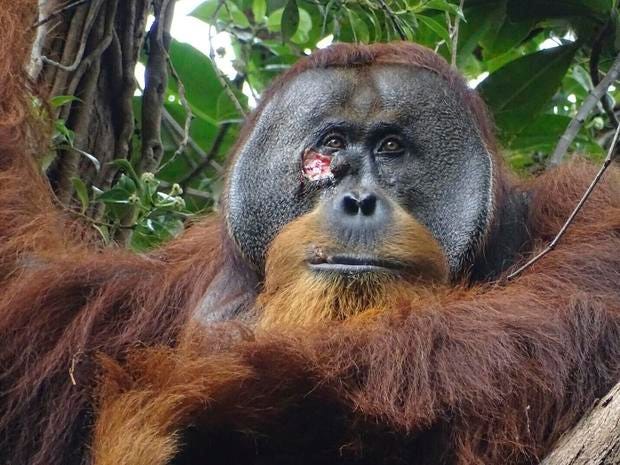Orangutan's Healing Wisdom: Using Medicinal Plants in the Wild
A Glimpse into the Intriguing World of Non-Human Primate Self-Medication

In a remarkable display of ingenuity and self-care, an orangutan named Rakus has captured the attention1 of scientists by using a medicinal plant to treat a wound—an unprecedented behavior observed in the wild. This groundbreaking discovery sheds new light on the remarkable abilities of animals to harness the healing properties of nature.
Unveiling Nature's Pharmacy: Rakus' Remarkable Discovery
Rakus, an adult male orangutan, was observed plucking and chewing leaves from a tropical plant known for its medicinal properties. With a keen instinct for self-preservation, Rakus then applied the plant's juices to an injury on his right cheek, fashioning a makeshift bandage with the chewed leaves. This extraordinary behavior, captured by field researcher Ulil Azhari in 2022, marks the first documented instance of a wild animal using medicinal plants directly on a wound.

Insights from the Field: Understanding Rakus' Healing Ritual
Researchers from the Max Planck Institute of Animal Behavior in Konstanz, Germany, were astounded by Rakus' behavior. Co-author Isabelle Laumer remarks,
"This is the first time that we have observed a wild animal applying a quite potent medicinal plant directly to a wound."
Despite the rarity of orangutans consuming this particular plant, Rakus instinctively recognized its healing potential—a testament to the remarkable intelligence of these great apes.
Exploring the Origins: A Glimpse into Evolutionary Medicine
The discovery of Rakus' healing ritual raises intriguing questions about the origins of medicinal practices in animals. Emory University biologist Jacobus de Roode suggests, "Very likely it's self-medication," highlighting the selective application of the plant solely to the wound. The practice of using plants for healing may have deep evolutionary roots, with potential implications for understanding human medicine.
Contextualizing Rakus' Behavior: Insights from Primate Research
Rakus' innovative approach to self-healing finds resonance in the behaviors of other primates. Bornean orangutans and other great apes have been observed using plants to alleviate pain and treat ailments, showcasing a sophisticated understanding of their environment. Chimpanzees and gorillas, too, exhibit behaviors indicative of self-medication, offering valuable insights into the evolutionary origins of medicinal practices.
The Significance of Rakus' Discovery: A Window into Animal Intelligence
Tara Stoinski, president of the Dian Fossey Gorilla Fund, underscores the significance of Rakus' behavior, stating,
"If this behavior exists in some of our closest living relatives, what could that tell us about how medicine first evolved?"
Rakus' remarkable discovery opens doors to deeper exploration of animal intelligence and the intricate relationship between species and their environment.
Concluding Thoughts: Navigating the Frontier of Animal Medicine
As scientists continue to unravel the mysteries of animal behavior, Rakus' healing ritual serves as a poignant reminder of the boundless wonders of the natural world. From the lush rain forests of Southeast Asia to the savannas of Africa, animals exhibit remarkable adaptations and behaviors that continue to inspire awe and admiration. In the evolving tapestry of life on Earth, Rakus' story stands as a testament to the enduring resilience and resourcefulness of the animal kingdom.
Laumer, I. B., Rahman, A., Rahmaeti, T., Azhari, U., Hermansyah, Atmoko, S. S. U., & Schuppli, C. (2024). Active self-treatment of a facial wound with a biologically active plant by a male Sumatran orangutan. Scientific Reports, 14(1), 1–7. https://doi.org/10.1038/s41598-024-58988-7

 vigna
vigna 






